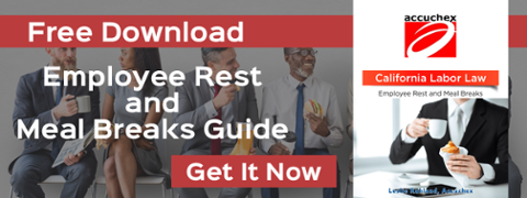California employers are required to provide regular meal and rest breaks for workers. But being clear with these California labor laws can be be a challenge.

Businesses are different in many ways, including their workforce structure and employee make-up. For example, some companies only employ part-time employees, while others have no part-timers and all employees are full time.
Some California businesses, while based in California, also employ workers in other states and sometimes even in other countries. In addition to actual employees, there are businesses that make large use of independent contractors. And others have mostly piece-rate workers or agricultural workers.
Consequently, staying compliant and up-to-date with meal and rest break requirements and regulations can be a large task for workforce management and HR staff.
Gaining Clarity and Maintaining Compliance
Almost every year California passes new legislation that either adds to or changes various labor regulations and reporting requirements. And it is the task of the State of California Department of Industrial Relations (DIR) and other agencies to ensure that employers and businesses in California are up to date on these changes.
This is critical since a failure in compliance by employers and managers can lead to costly labor claims, penalties, and even employee lawsuits. And states such as California have been shown to be statistically more likely to engender claims and lawsuits than most others.
A High-Level Review of Break Laws in California
There are a number of California labor laws that commonly create issues for employers and managers. Here are some of the more common break law compliance challenges:
Hours Worked
According to the labor law, hours worked means:
“the time during which an employee is subject to the control of an employer, and includes all the time the employee is suffered or permitted to work, whether or not required to do so.”
The state of California permits “rounding” of employee time to the nearest one-tenth, five minutes, or a quarter hour for calculating actual hours worked. This approach is not allowed, however, if it can result in the failure to properly compensate your employees for the time they have worked.
Employers are allowed to disregard “insignificant periods of time” outside the regular scheduled working hours that cannot be precisely recorded for payroll purposes. This only applies, however, if these periods of time are occasional periods of time that only last a few seconds or minutes.
Meal Breaks
Employees must be provided with a meal break of at least 30 minutes, in California, if they work more than five hours in the day. This meal period must begin before, or at, the end of an employee’s fifth hour of work. If an employee works more than 10 hours in the same day, a second meal period is due.
Meal periods are not considered paid time and employees must clock in and out for meal periods.
The California Supreme Court has previously established that there is no prohibition on taking meal periods early in a shift, although this can result in an employee working more than five hours after the meal. In addition, while employers must provide meal breaks, they do not need to require employees to use those breaks.
During meal breaks, employees must be relieved of all duties and employers cannot regulate their activities. In addition, employees must be permitted a “reasonable opportunity” to take an uninterrupted 30-minute break.
Although employers cannot “impede or discourage” employees from taking a meal break, they are also not required to ensure that no work is being done during those breaks.
In certain limited situations meal periods may be waived:
- If the employee will work no more than six hours total in the day, and the employee and employer agree to waive the meal period; and
- If the employee works between 10 and 12 hours, the second meal period may be waived if the first meal period was not waived.
If an employee works more than 10 hours the employer must provide a second meal break of at least 30 minutes. This second meal break must be given no later than the end of the employee's 10th hour of work.
Rest Breaks
California labor law also requires that employers must “authorize and permit” employees to take one 10-minute rest period for each four-hour work period, or “major fraction thereof", which is anything more than two hours, according to the California Supreme Court.
As a result, rest periods must be provided as follows:
- Employees working between 3 1/2 and 6 hours are entitled to one paid 10-minute break
- Employees working between 6 hours and 10 hours are entitled to two paid10-minute breaks
- Employees working between 10 hours and 14 hours are entitled to three paid 10-minutes breaks; and so on.

Although it is not required by the law, rest breaks should be taken, within reason, in the middle of each work period.
In general, one rest break should be allowed before the meal break, and one should be after, if an employee is working an eight-hour shift. Rest breaks count as time worked and employees must be paid for this time. Employers are also required to provide a suitable rest facility such as a break area or kitchen.
If employees are not allowed to take a rest period, the law entitles them to one hour of pay at the their regular rate of pay for each workday that rest periods are not made available.
Piece-Rate Worker Break Periods
The state Labor Code was updated in 2016 and addresses California employers who pay employees a piece-rate for any part of their work.
- Employers are required to pay piece-rate employees for rest and recovery periods, and all periods of “other nonproductive time” separately from, and in addition to, their piece-rate pay.
- Because there is no collective bargaining exemption, it also applies to employers of unionized employees.
Employers must pay piece-rate employees for rest and recovery periods at an hourly rate determined by dividing the employee’s total compensation for the workweek (excluding compensation for rest and recovery periods and overtime premiums) by the total hours worked during the workweek (not including rest and recovery periods).
Break Laws for Agricultural Workers
Agriculture and outdoor workers such as landscaping and farming employees are entitled to sufficient rest breaks when temperatures exceed 85 degrees. This is defined as a minimum five minutes in the shade, on an “as needed” basis.
The law covers all agricultural employees, including illegal immigrants.
If an employee does not receive the proper meal and rest periods the employer must pay to the employee one hour of pay as a penalty. This penalty also applies to “recovery periods” or “cool down periods afforded an employee to prevent heat illness.”
Meetings, Training and Lectures
California follows the federal law for determining whether employees should be paid for time spent attending meetings, lectures and training. This time is not counted as “hours worked” if:
- Attendance is outside regular work hours
- Attendance is voluntary
- The course, lecture or meeting is not related directly to the employee’s job training, and
- The employee does not perform any productive work during the training, lecture or meeting
Travel Time
California law requires that employees be paid for all hours of work-related travel, regardless of whether those hours are during “normal” working hours, or for longer assignments. The law does not require employers to pay employees for commuting to and from work, however, and an employer can establish a different rate of pay for travel time if they chose.
In addition, in California, employers who require their workers to use personal vehicles for work-related tasks may be liable for employee car accidents during a commute or even on a personal errand during "normal" work hours.
Payroll Management Compliance With California Labor Law
As a business owner, or HR or payroll manager, you have a number of options for your payroll functions. Software that can be installed in-house, or cloud-based programs offer a good alternative.
But if you really want to take full advantage of the benefits available to you, outsourcing to a provider like Accuchex can still be the best decision.
If you are currently looking to invest in outsourcing, download our free resource, the Payroll Outsourcing Guide, to help you make an informed decision.
Or call Accuchex Payroll Management Services at 877-422-2824.





